Complete Solutions to SOLUTIONS OF NCERT EXEMPLAR PROBLEMS of chapter LINEAR PROGRAMMING of Class 12 book with complete answers and questions
| Class 12 | MATHS |
| Chapter | LINEAR PROGRAMMING |
| KUMAR PRAKASHAN | SOLUTIONS OF NCERT EXEMPLAR PROBLEMS |
| Number Of Questions | 44 |
| Academic Year | 2023-24 |
Determine the maximum value of z = 11x + 7y subject to the constraints :
`2x+y le 6, x le 2, x ge 0, y ge 0`02:33View SolutionMaximise Z = 3x + 4y, subject to the constraints : `x+y le 1, x ge 0`.
01:30View SolutionMaximize the function `z = 11x + 7y` , subject to the constraints : `x le 3, y le 2, x ge 0, y ge 0`
02:48View SolutionMinimise z = 13x - 15y subject to the constraints : `x+y le 7, 2x-3y+6 ge 0, x ge 0, y ge 0`
06:42View SolutionDetermine the maximum value of z = 3x + 4y if the feasible region (shaded) for a LPP is shown in Figure.
 04:45View Solution
04:45View SolutionFeasible region (shaded) for a LPP is shown in Figure Maximise z = 5x + 7y.
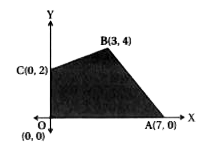 01:45View Solution
01:45View SolutionThe feasible region for a LPP is shown in Figure. Find the minimum value of `z=11x+7y`.
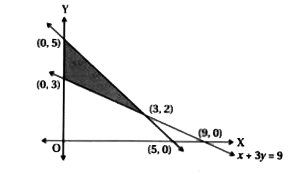 01:52View Solution
01:52View SolutionFind the maximum value of `Z = 4x + y` subject to the constraints `2x+y le 23, x ge 0, y ge 0` is ……….
02:32View SolutionThe feasible region for a LPP is shown in Figure. Evaluate z = 4x + y at each of the corner points at this region. Find the minimum value of z, if exists.
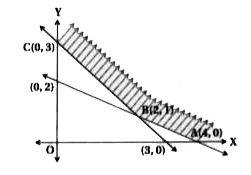 02:38View Solution
02:38View SolutionIn Figure, the feasible region (shaded) for a LPP is shown. Determine the maximum and minimum value of z = x + 2y.
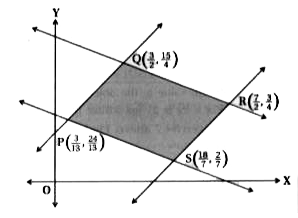 03:26View Solution
03:26View SolutionA manufacturer of electronic circuits has a stock of 200 resistors, 120 transistors and 150 capacitors and is required to produce two types of circuits A and B. Type A requires 20 resistors, 10 transistors and 10 capacitors. Type B requires 10 resistors, 20 transistors and 30 capacitors. If the profit on type A circuit is Rs. 50 and that on type B circuit is Rs. 60, formulate this problem as a LPP so that the manufacturer can maximize his profit.
05:49View SolutionA firm has to transport 1200 packages using large vans which can carry 200 packages each and small vans which can take 80 packages each. The cost for engaging each large van is Rs. 400 and each small van is Rs. 200. Not more than Rs. 3000 is to be spent on the job and the number of large vans can not exceed the number of small vans. Formulate this problem as a LPP given that the objective is to minimize cost.
View SolutionA company manufactures two types of screws A and B. All the screws have to pass through a threading machine and a slotting machine. A box of Type A screws requires 2 minutes on the threading machine and 3 minutes on the slotting machine. A box of type B screws requires 8 minutes of threading on the threading machine and 2 minutes on the slotting machine. In a week, each machine is available for 60 hours.
On selling these screws, the company gets a profit of Rs. 100 per box on type A screws and Rs. 170 per box on type B screws.View SolutionA man rides his motorcycle at the speed of 50 km/hour. He has to spend Rs. 2 per km on petrol. If he rides it at a faster speed of 80 km/hour, the petrol cost increases to Rs. 3 per km. He has atmost Rs. 120 to spend on petrol and one hour's time. He wishes to find the maximum distance that he can travel.
Express this problem as a linear programming problem.03:56View SolutionRefer to question 11. How many of circuits of Type A and of Type B, should be produced by the manufacturer so as to maximise his profit? Determine the maximum profit.
10:52View SolutionFind the minimum value of `Z = x + y` subject to the constraints `2x+3y le 6, x ge 0, y ge 0` is ……….
02:19View SolutionSolve the following linear programming problems graphically :
Maximize : `Z = 100x + 170y` subject to the constraints `3x+2y le 3600, x+4y le 1800, x, y ge 0`.06:42View SolutionSolve the following linear programming problems graphically :
Maximize : `Z = x + 170y` subject to the constraints `3x+2y le 6, x+4y le 16, x, y ge 0`.03:43View SolutionRefer to question 15. Determine the maximum distance that the man can travel.
08:56View SolutionMaximise z = x + y subject ot `x+4y le 8, 2x+3y le 12, 3x+y le 9, x ge 0, y ge 0`.
06:07View SolutionA manufacturer produces two models of bikes model X and model Y. Model X takes a 6 man hours to make per unit, while Model Y takes 10 man-hours per unit. There is a total of 450 man-hour available per week. Handling and Marketing costs are Rs. 2000 and Rs. 1000 per unit for Models X and Y respectively. The total funds available for these purposes are Rs. 80,000 per week. Profits per unit for Models X and Y are Rs. 1000 and Rs. 500, respectively. How many bikes of each model should the manufacturer produce, so as to yield a maximum profit ? Find the maximum profit.
09:10View SolutionIn order to supplement daily diet, a person wishes to take some of x and some wishes y tablets. The contents of iron, calcium and vitamins in x and y (in milligrams per tablet) are given as below :

The person needs atleast 18 milligrams of iron, 21 milligrams of calcium and 16 milligram of vitamins. The price of each tablet of X and Y is Rs. 2 and Rs. 1 respectively. How many tablets of each should the person take in order to satisfy the above requirement at the minimum cost ?View SolutionA company makes 3 model of calculators : A, B and C at factory (I) and factory (II). The company has orders for atleast 6400 calculators of model A, 4000 calculator of model B and 4800 calculators of model C. At factory (I), 50 calculators of model A, 50 of model B and 30 of model C are made everyday, at factory (II), 40 calculators of model A, 20 of model B and 40 of model C are made everyday. It costs Rs. 12000 and Rs. 15000 each day to operate factory (I) and (II), respectively. Find the number of days each factory should operate to minimise the opertaing costs and still meet the demand.
11:09View SolutionMaximise `Z = 10x + 7y`
subject to `2x+2y ge 16`,
`" "6x+10y le 30`,
`" "x ge 0, y ge 0`03:20View SolutionThe corner points of the feasible region determined by the system of linear constraints are (0, 0), (0, 40), (20, 40), (60, 20), (60, 0). The objective function is z = 4x + 3y.
Compare the quantity in Column A and Column B
 02:23View Solution
02:23View SolutionThe feasible solution for a LPP is shown in Figure
Let z = -3x - 4y
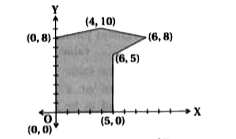
objective function. Minimum of Z occurs at02:01View SolutionThe feasible solution for a LPP is shown in Figure
Let z = -3x - 4y

objective function. Maximum of Z occurs at02:31View SolutionThe corner points of the bounded feasible region are `(0, 0), (0, 8), (4, 10), (6, 8),(6, 5)` and `(5, 0)`. For the objective function `z = 3x -4y ………` (Maximum value of z + Minimum value of z) is equal to
02:26View SolutionThe feasible region for an LLP is shown in the Figure. Let z = 3x - 4y be the objective function. Maximum value of z is
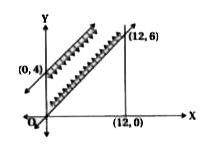 01:43View Solution
01:43View SolutionThe feasible region for an LLP is shown in the Figure. Let z = 3x - 4y be the objective function. Minimum value of z is
 01:46View Solution
01:46View SolutionCorner points of the feasible region for an LPP are (0, 2), (3, 0), (6, 0), (6, 8) and (0, 5).
Let F = 4x + 6y be the objective function. The Minimum value of F occurs at ………..02:17View SolutionCorner points of the feasible region for an LPP are (0, 2), (3, 0), (6, 0), (6, 8) and (0, 5).
Let F = 4x + 6y be the objective function. (Maximum of F)-(Minimum of F) =02:06View SolutionCorner points of the feasible region determined by the system of linear constraints are (0, 3), (1, 1) and (3, 0). Let Z = px + qy, where `p, q gt 0`. Condition on p and q, so that the maximum of Z occurs at (3, 0) and (1, 1) is ……….
02:13View SolutionIn a LPP, the linear inequalities or restrictions on the variables are called …………… .
01:45View SolutionIn a LPP, the objective function is always ………….
01:18View SolutionIf the feasible region for a LPP is …………, then the optimal value of the objective function z = ax + by may or may not exist.
01:23View SolutionIn a LPP if the objective function z = ax + by has the same maximum value on two corner points of the feasible region, then every point on the line segment joining these two points give the same ………. Value.
01:46View SolutionA feasible region of a system of linear inequalities is said to be ………… if it can be enclosed within a circle.
01:18View SolutionA corner point of a feasible region is a point in the region which is the ……….. of two boundary lines.
01:46View SolutionThe feasible region for an LLP is always a …….. polygon.
01:23View SolutionIf the feasible region for a LPP is unbounded, maximum or minimum of the objective function Z = ax + by may or may not exist.
02:17View SolutionMaximum value of the objective function Z = ax + by in a LPP always occurs at only one corner point of the feasible region.
02:08View SolutionIn a LPP, the minimum value of the objective function Z = ax + by is always 0, if origin is one of the corner point of the feasible region.
02:20View SolutionIn a LPP, the maximum value of the objective function z = ax + by is always finite.
01:44View Solution
SOLUTIONS OF NCERT EXEMPLAR PROBLEMS questions and complete solutions for chapter LINEAR PROGRAMMING of KUMAR PRAKASHAN KENDRA MATHS (GUJRATI ENGLISH) of Class 12
